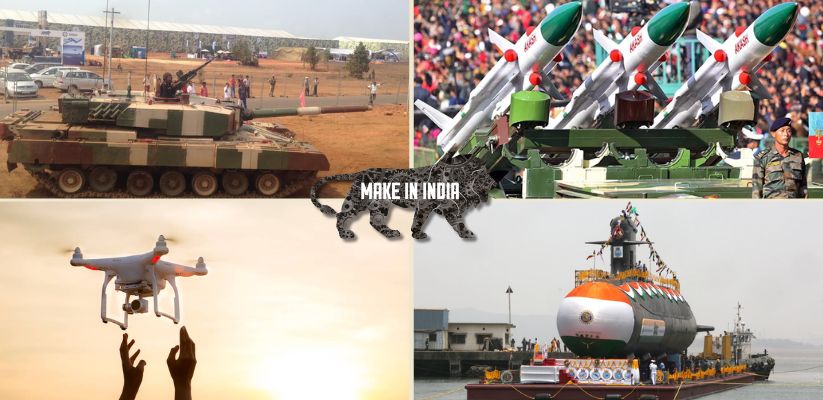India is fast emerging as a global defence superpower, and going through a transformative change in recent years. From being a defence importer to an exporter, the country has witnessed a record number of indigenous defence production and exports including Brahmos, Akash, and 155 mm artillery gun ascendancy, among others.
Recently, India’s Defence Minister Rajnath Singh chaired a meeting of the Defence Acquisition Council (DAC). It cleared the acquisition of new projects worth Rs. 84,560 Crore. These projects include various new-generation state-of-the-art defence equipment such as anti-tank mines with seismic sensors and remote deactivation capability, heavy-weight torpedoes, and multi-mission maritime aircraft, among others. The move aims to foster innovation, enhance national security, meet geo-political challenges, and modernize the Indian Armed Forces.
Challenges Faced by India’s Defence Sector
Indian Defence Sector faces a host of challenges. Some of them are as under:
- Over-reliance on Imports: India is heavily reliant on other countries for defence acquisition. Not only does it cause delays in the acquisition process, but it also poses a threat to national security.
- Lack of Participation of Private Sectors: The private sector in India needs more participation in defence manufacturing. As a result, the country needs more innovation and inefficiencies in the defence industry.
- Bureaucratic Hurdles: The bureaucracy in India is one of the key hurdles behind defence deal procurement and the advancement of the defence sector. Despite India’s strong potential, it slows down the policy implementation.
- Limited Innovation: Traditionally, there has been a greater focus on the manufacturing of defence equipment, rather than innovation. India should adopt new strategies for disruptive innovation, and use advanced technology.
How the Govt is Overcoming These Challenges?
Historically, the Government gave little to no emphasis on improving the condition of the public sector which constitutes a major stake in the manufacturing of the defence equipment. The new Government has undertaken several reforms in the public sector, such as giving autonomy to the Defence Public Sector Undertakings (DPSUs). The new DPSUs are autonomous and accountable for their performance and revenue generation. The Govt also appointed the first-ever Chief of Defence Staff (CDS), responsible for promoting the indigenization of the defence sector.
Furthermore, the Govt has also increased the allocation for the defence sector by 4.72% to Rs. 6.21 Lakh Crore in FY25. The Govt has allocated a whopping Rs. 1 Lakh Crore of the defence capital procurement budget for the domestic industry in FY 2023-24. It accounts for a record 75%.
The Govt has taken a series of other measures to transform the import-dependent industry, promote indigenous designs, and overcome the above challenges. For example, India is encouraging foreign Defence Original Equipment Manufacturers (OEMs) to not only invest in the Indian defence sector but also export from India. Recently, the Prime Minister has inaugurated India’s largest helicopter manufacturing factory, Hindustan Aeronautics Limited (HAL), in Karnataka.
Defence Industry Key Acquisition Projects Approved by DAC
The Defence Acquisition Council (DAC) has approved the acquisition of the new-generation anti-tank mines equipped with seismic sensors, remote deactivation, and other major security features. It has also approved air defence tactical control radar, heavy-weight torpedoes, medium-range maritime reconnaissance, multi-mission maritime aircraft, flight refueller aircraft, and software-defined radios.
Key Amendments in Defence Acquisition Procedure (DAP), 2020
The Government of India has also approved crucial amendments to the Defence Acquisition Procedure (DAP), 2020. These amendments are aimed at harnessing innovation from Indian startups and Micro, Small, and Medium Enterprises (MSMEs).
The DAP is aimed at the timely acquisition of military equipment required by the Indian Armed Forces. It is meant to improve the core capabilities, performance, and security of the armed forces by bringing transparency and accountability throughout the defence acquisition process. It also contains several provisions to simplify the acquisition of modern technology and defence products.
Budgetary Allocations for FY25
The Government has given the highest priority to the defence sector and its modernization in its interim budget for FY25. Union Minister of Finance Nirmala Sitharaman presented a budget on February 1, 2024, which allocated Rs. 6.21 Lakh Crore for the defence sector, an increase of 4.72% from the previous year of Rs. 5.94 Lakh Crore. This amount constituted 13% of the total Budget.
Strategic Objectives Behind Defence Acquisitions
What could be the strategic objectives behind the recent acquisitions? Read on to find out.
- Boost Make in India: The Government of India has launched the Make in India initiative for India’s self-reliance in the manufacturing and defence sectors. The recent acquisitions are in line with these strategic objectives.
- Enhancing Operational Efficiency: Another objective is to enhance the operational efficiency of Indian Amed Forces and make maximum use of the resources.
- Enhance Indian Dominance: The Government is promoting indigenous technology, innovations, and defence products, to enhance India’s dominance in the Tactical Battle Area.
- Leverage Advanced Technology: These acquisitions are aimed at promoting innovations in the defence sector through the medium of Defence Excellence (iDEX) and the Technology Development Fund (TDF).
Final Words
The Government of India has set an ambitious plan to prioritize the production and export of indigenous products. The recent acquisition and changes to the Defence Acquisition Procedure, 2020 are a reflection of the Government’s initiative to boost the Make in India initiative and strengthen India’s defence sector. These acquisitions are aimed to meet India’s complex geopolitical needs with the help of cutting-edge technology and innovation.





